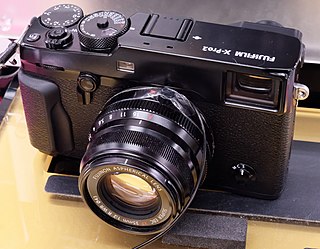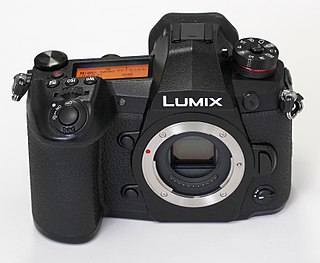
A digital single-lens reflex camera is a digital camera that combines the optics and the mechanisms of a single-lens reflex camera with a solid-state image sensor and digitally records the images from the sensor.

The Micro Four Thirds system is a standard released by Olympus and Panasonic in 2008, for the design and development of mirrorless interchangeable lens digital cameras, camcorders and lenses. Camera bodies are available from Blackmagic, DJI, JVC, Kodak, Olympus, Panasonic, Sharp, and Xiaomi. MFT lenses are produced by Cosina Voigtländer, DJI, Kowa, Kodak, Mitakon, Olympus, Panasonic, Samyang, Sharp, Sigma, SLR Magic, Tamron, Tokina, TTArtisan, Veydra, Xiaomi, Laowa, Yongnuo, Zonlai, Lensbaby, Venus Optics and 7artisans amongst others.

A mirrorless camera is a camera that does not have a mirror. Though most cameras, including those used in smartphones, lack mirrors, the term mirrorless is primarily used to describe digital interchangeable lens cameras, in order to distinguish them from DSLRs, which have historically dominated interchangeable lens cameras. Lacking a mirror system allows the camera to be smaller, quieter, and lighter.

The Olympus OM-D E-M5, announced in February 2012, is a Micro Four Thirds compact mirrorless interchangeable lens camera. In style and name it references the Olympus OM series of film SLR cameras, but it is not an SLR camera. The successor is the Olympus OM-D E-M5 Mark II.

The Olympus PEN E-PL5, announced on September 17, 2012 is Olympus Corporation's tenth camera that adheres to the Micro Four Thirds (MFT) system design standard. The E-PL5 succeeds the Olympus PEN E-PL3, and was announced in concert with one other model, the Olympus PEN E-PM2.
In Sony digital cameras, the acronym ILCE stands for "Interchangeable Lens Camera with E-mount". In August 2013, Sony announced the first model of the ILCE mirrorless camera with E-mount, electronic viewfinder, contrast-detection autofocus and Multi Interface Shoe, the ILCE-3000. In October 2013, two full-frame E-mount cameras were announced, the ILCE-7 and ILCE-7R.

The Olympus OM-D E-M1 Micro Four Thirds is Olympus' compact mirrorless interchangeable-lens camera introduced on September 10, 2013. It has built-in on sensor phase detection.

The Sony α7, α7R, α7S and α7C are four closely related families of full-frame mirrorless interchangeable-lens cameras. The first two were announced in October 2013, the third in April 2014 and the fourth in September 2020. They are Sony's first full-frame mirrorless interchangeable lens cameras and share the E-mount with the company's smaller sensor NEX series.

The Olympus PEN E-P5 is a mirrorless interchangeable-lens camera in the micro four thirds system released in October 2013. This is, despite its number, the fourth model in the PEN E-P range. It remained the latest model in the E-P series until the introduction of the E-P7 in the summer of 2021. It includes the same 16 MP sensor as the Olympus OM-D E-M5. The E-P5 comes in three colour schemes; black, silver and white.

The Olympus OM-D E-M5 Mark II is a digital interchangeable-lens camera announced in February 2015. It features a new 40-megapixel high-resolution mode that uses sensor shift to generate overlapping 16-megapixel images to then compute a 40-megapixel composite. It is the successor of the Olympus OM-D E-M5. Compared to that earlier model from 2012 and flagship OM-D E-M1 released in 2013, both of which are claimed to have 4 f-stops of shake compensation when shooting handheld, Olympus claims the OM-D E-M5 II can compensate 5 f-stops.

The Olympus OM-D E-M10 Mark II is a digital mirrorless system camera announced by Olympus Corporation on August 25, 2015.

The Sony RX is the name of a range of fixed lens compact point-and-shoot digital cameras created by Sony in 2012. All cameras are equipped with Carl Zeiss lenses.

The Fujifilm X-Pro2 is a mirrorless interchangeable-lens digital camera announced in January 2016. It is part of Fujifilm's X-Series of cameras, the successor to the X-Pro1. Sales began on 3 March 2016.

The Olympus PEN-F is a mirrorless interchangeable-lens camera in the Micro Four Thirds system, released in 2016. It is the part of the digital PEN series. The PEN-F pays tribute to the similarly named PEN F half-frame 35mm film SLR camera from 1963.

The Panasonic Lumix DC-G9 is a Micro Four Thirds mirrorless interchangeable lens camera body announced by Panasonic at the end of 2017.

The Olympus OM-D E-M1 Mark II is a digital mirrorless interchangeable-lens camera released by Olympus Corporation in December 2016. It replaced the Olympus OM-D E-M1, which was introduced in 2013.

The Olympus OM-D E-M1X is a professional mirrorless interchangeable-lens camera announced by Olympus Corporation in January 2019.

Pixel shift is a method in digital cameras for producing a super resolution image. The method works by taking several images, after each such capture moving ("shifting") the sensor to a new position. In digital colour cameras that employ pixel shift, this avoids a major limitation inherent in using Bayer pattern for obtaining colour, and instead produces an image with increased colour resolution and, assuming a static subject or additional computational steps, an image free of colour moiré. Taking this idea further, sub-pixel shifting may increase the resolution of the final image beyond that suggested by the specified resolution of the image sensor.

The Olympus OM-D E-M5 Mark III is the third iteration of the enthusiast-level mirrorless interchangeable-lens camera produced by Olympus on the Micro Four-Thirds system. The camera is the successor to the Olympus OM-D E-M5 Mark II and was released on November 15, 2019.

The Canon EOS R3 is a 24 megapixel full-frame mirrorless interchangeable-lens camera launched by Canon officially announced by Canon on 14 September 2021 alongside two RF mount lenses. The camera is available as body only with a MSRP of US$5,999.00.



















